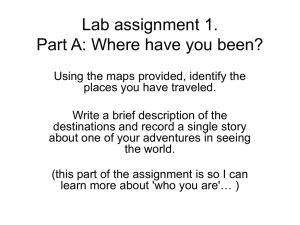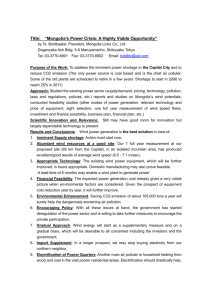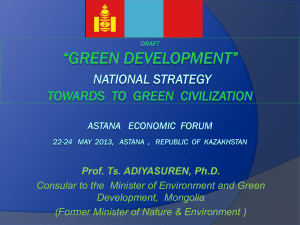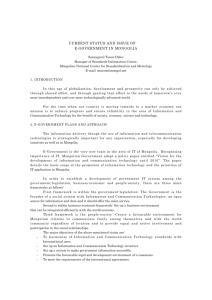With Case Studies from: The National Renewable Energy Corporation of Mongolia
advertisement
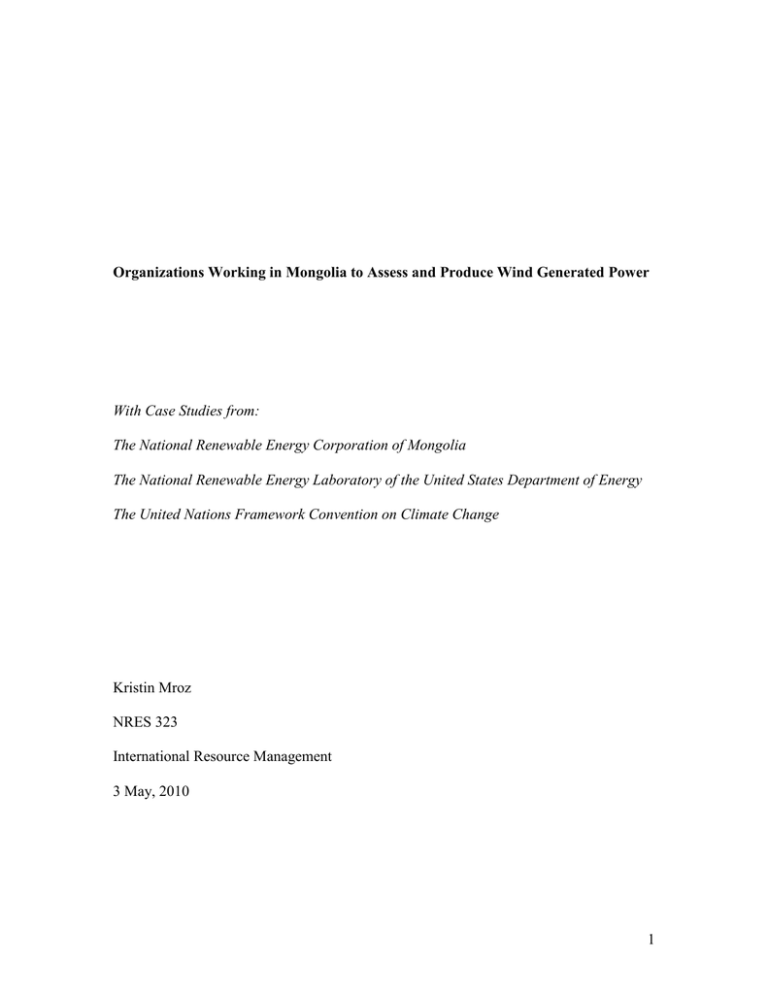
Organizations Working in Mongolia to Assess and Produce Wind Generated Power With Case Studies from: The National Renewable Energy Corporation of Mongolia The National Renewable Energy Laboratory of the United States Department of Energy The United Nations Framework Convention on Climate Change Kristin Mroz NRES 323 International Resource Management 3 May, 2010 1 Executive Summary As the world becomes more concerned about greenhouse gases, countries are beginning to switch to renewable energies. Mongolia, a country with vast coal deposits, is attempting to incorporate wind-powered energy to supply Mongolians with electricity. Mongolia has a high potential for wind-generated power. Although coal is used for 80 percent of Mongolia’s current energy source because it is abundant and cheap, wind power is a more sustainable way to produce energy. In this paper, three case studies of organizations assessing and implementing wind generated power in Mongolia: a domestic organization - the National Renewable Energy Corporation of Mongolia (NREC), a foreign organization - the National Renewable Energy Laboratory (NREL) from the United States Department of Energy, and a multi-international organization – the United Nations Framework Convention on Climate Change (UNFCCC). As a part of the Mongolian government, the National Renewable Energy Corporation aims to create a more sustainable country. The NREC has placed 4,000 FORTIS and PROVEN small-scale wind turbines in rural Mongolia but have struggled to create dependable and safe turbines. Most are costly and inefficient but remain reliable when safely usable. A study by the NREC found that renewable energy sources increase the standard of living for Mongolians. The NREC also regularly collects information from weather stations around the country and has produced a Wind Energy Atlas. The Atlas found that vast areas of Mongolia can support wind-energy generators and Mongolia is able to produce more than enough energy for the country from wind alone. Although most Mongolians live in urban areas, many continue to live as nomadic herders in rural Mongolia. 2 Although the National Renewable Energy Laboratory is part of the United States government, the NREL is helping Mongolia succeed in renewable energy production with the Mongolian Wind Resource Assessment Project. The NREL has produced a detailed wind map of Mongolia using GIS, which outlines all 21 of Mongolia’s aimags wind power potential. The Wind Resource Map goes into great detail using various data from weather stations in Mongolia and computer technology. The United Nations Framework Convention on Climate Change is a treaty, mandating signed countries to follow protocols in order to limit greenhouse gases. Mongolia signed the UNFCCC in 1992 and is now required to mitigate greenhouse gases. The last convention, the Copenhagen Accord, suggested that Mongolia use portable small-scale wind turbines for rural nomadic herders. In addition, large-scale wind generation farms should be used for urban power. Most recently, the ERBD, Japan, and Luxemburg have committed a large amount of money for a 50 MW wind farm near Ulaanbaatar. The Mongolian government owns all other wind-generated power in Mongolia. The government has pledged to use 25 percent renewable energy by the year 2020. Although the process of implementing wind generated power in Mongolia seems slow and nearly impossible at times, due to lack of finances, technology, and support, wind generated power continues to play a large role in Mongolia. The areas in Mongolia with the most potential for wind turbines have been located and exhaustively studied. Even though coal is abundant and cheap, Mongolia has made commitments to reduce their greenhouse gases, and wind power is a great alternative for the country. With the 3 help of various organizations and countries, Mongolia may be able to finance for wind power and reach their goal of 25 percent renewable energy by 2020. Literature Review When countries around the world were developing into industrialized and developed nations, renewable energy resources were not developed on a large scale. Fossil fuels, such as coal, oil, and natural gas, were abundant and cheap so the world’s wealthy nations grew fast. Today, as the world watches developing nations turn into industrial power-houses, many people are advising that these newly developed nations start with renewable energy resources in order to save money as well as prevent more greenhouse gasses from entering our world’s atmosphere. Therefore, a renewable source, such as wind, is becoming a valuable resource around the world. Mongolia is just one example of a country that is exploring wind-generated power potential as a sustainable energy resource. In order to generate the large-scale wind farms, a few groups have come into the country to assess its potential as a wind-energy source and a few projects have been started. Domestic, foreign, and multi-international organizations have been selected as case studies for this report. Three organizations have provided funding and research for a more sustainable Mongolia; the National Renewable Energy Corporation of Mongolia, the National Renewable Energy Laboratory from the United States Department of Energy, and the United Nations Framework Convention on Climate Change. According to the Global Wind Energy Council website, wind power has grown steadily over the last decade, at an average rate of 30% annually. World wide, the use of 4 wind turbines on agricultural land, on tops of mountain ridges, and in the oceans totals over 120 gigawatts (GW) of energy generated. The largest in 2007 was the Enercon E126, which held a capacity of 6 megawatts (MW). The largest wind farm in the world is located in Texas and contains 420 turbines and produces 735 MW of energy. Together, the Asian market added nearly one third of the total new wind generators installed worldwide in 2008. In total, €36.5 billion ($50 billion) was spent on turbine instillations worldwide that year. Almost half a million people are employed in some way by the wind energy industry and that number is growing steadily. With the current use of wind energy, over 158 million tons of carbon dioxide are saved from entering the atmosphere annually. Today, the United States leads with the world in wind energy generation, producing over 25,000 MW (Zervos, 2010). Wind energy is now being produced world-wide and developing nations have began turning to wind powered renewable energy. Mongolia, sandwiched between Russia and China, has a high potential for windpowered energy. As an emerging and developing country with a large land size, Mongolia is an excellent choice for renewable energy practices, according to McElroy at al. (2009). Currently, coal is used as the major source of energy in the area because it is abundant and cheap. However, with the advancement of wind turbine technology and its widespread use and production, wind powered energy is becoming a cost effective way to harness energy sustainably (McElroy et al., 2009). A sustainable energy resource is one that can be used renewably over our lifetimes and brings little to no impact on our world’s ecosystems. 5 According to the Institute of Asian Research (2006), Mongolia has vast natural resources, mainly coal, copper, molybdenum, fluorspar, tin, tungsten, and gold, and therefore has the potential to develop into a strong industrialized nation. The report stresses to the Mongolian government that a sustainable and energy efficient future is necessary to succeed. The report suggests that the Mongolian government should require a certain amount of renewable energies to be used for mining natural resources. In 2001, the Mongolian Mineral Law was signed which required mining companies to present an environmental protection plan, “addressing air quality, water usage, and development of sustainable energy sources” (Khushrushahi et al., 2006). Currently, according to Noushin Khushrushahi et at. (2006), Mongolia receives the majority of energy from coal-powered plants. Coal is a readily available fuel because nearly half of Mongolia is a coal basin. This makes coal very easy to obtain and very cheap for energy generation. Because Mongolia uses so little energy (compared to developed nations), most people see little sense in changing to a more expensive and harder to install renewable energy. Up to eighty percent of Mongolia’s energy is from coal and the remaining comes mostly from hydroelectric generators. To date, Mongolia uses just under 800 MW of energy but is steadily increasing their need for energy. In theory, the cheapest and easiest way for Mongolia to obtain more power would be to import their energy from China (Khushrushahi et al., 2006). Mongolia has a total area of 1,565,600 kilometers (km)2 and includes six different ecosystems (Alpine, Taiga, Forest-Steppe, Steppe, Desert-Steppe, and Desert). Mongolia suffers from many environmental issues, as noted by the United Nations Environmental Programme (UNEP) and the Regional Resource Centre for Asia and the Pacific 6 (RRC.AP). Some of which include the “lack of a centralized and accessible project/plan information system and early identification of projects,” desertification, deforestation, and “urban air pollution caused by . . . large soft coal fired, thermal power plants, industry and vehicles”. However, the report states that even though renewable energy resources, such as geothermal and wind generated energy, require large capital costs, they should maintain long term cost savings and provide skills and jobs for an ever-increasing industry (Khushrushahi et al., 2006). In a study funded by the Dutch Cooperation Fund for Promotion of Renewable Energy and Energy Efficiency and the Asian Development Bank, findings show that Mongolia has a great potential for renewable energy resources, especially from solar and wind resources. In addition, the study found that Mongolia uses inefficient technology and energy sources, such as coal and natural gas. Because of this study, the Mongolian government “plans to develop an Integrated Resource Planning and Demand Management framework that will facilitate reductions in energy consumption” (Khushrushahi et al., 2006). Assessment and Implementation from a Domestic Organization According to the National Renewable Energy Corporations (NREC) of Mongolia (2010), their missions statement “is to ensure sustainable, smooth and balanced economic and energy development through utilization of ecologically clean renewable energy.” The NREC is part of the Mongolian government and was started in 1987 to implement renewable energy generation for people living far from the centralized electricity grid. A Mongolian-English joint factory was initiated to produce small 50-watt wind turbines. In 7 addition, the NREC placed 4,000 portable wind turbines in rural Mongolia in 1990 (“National”). According to a study funded by the National Renewable Energy Corporation of Mongolia, under normal conditions, the use of renewable energy results in economic independence and raises living standards while reducing environmental impacts. In the study, hybrid systems are promoted. Hybrid energy systems combine wind, solar, and diesel generators to create energy so that there is always at least one source of power. However, the wind turbines in Mongolia have been slowly produced and small in size. Therefore, they remain at a high cost and are inefficient due to their small size. The wind speeds in Mongolia are varied and the wind turbines used for this study usually had a lower efficiency during slow winds or broke down during high impact winds. In this case, a hybrid system would help to even out the energy resources (Nikolakaki). In the past, small wind turbines have been problematic. Recently, an international law was passed so that the “design, installation, operation and maintenance of [wind turbines] with a rotor area smaller than 40 m2” become standard and safe. As a part of the study, five weather stations were positioned around Mongolia. The stations recorded anywhere from 4.0 meters per second (m/s) to 5.6 m/s mean monthly wind speed. The National Renewable Energy Corporation of Mongolia is in charge of collecting the data and making measurements. Eventually hybrid energy systems were put into place. The systems were used for energy as lighting in hospitals and schools, refrigeration and freezing in hospitals, and other regular household needs. In a joint study with the Asian Development Bank and the National Renewable Energy Corporation of Mongolia, a report titled “Promotion of renewable energy, energy 8 efficiency, and greenhouse gas abatement” (PREGA), promoted the use of renewable energy. The study found that the Gobi desert and Plains regions of Mongolia abound in wind. Mongolia, as a whole, produced 836.8 billion kilowatt hours (kWh) of wind, which is usable 3.5 - 4.6 thousand hours per year. A Wind Energy Atlas was produced for Mongolia and over 160,000 km2 of land was found “to have good-to-excellent wind potential for utility-scale applications.” This land amounts to about 10 percent of the total land in Mongolia that can theoretically produce up to 1,100,000 MW of energy from large-scale wind farms alone. In addition, rural, small-scale productions of wind turbines can be used in 50 percent of Mongolian land and support 4,300,000 MW of energy. At the time being, wind generators are used in Mongolia in remote rural areas to generate low amounts of energy because they cost less than using diesel generators (“Promotion”, 2004). The World Bank, which provides financial and technical assistance to developing countries around the world, began working with the NREC to improve lives of nomads in Mongolia in the year 2006. Nearly 1.1 million people live in rural Mongolia where less than one quarter of those people have access to electricity. To contrast, nearly 90 percent of Mongolians living in urban areas (around 1.5 million people) have a much more reliable access to electricity (Rivera, 2006). Because the terrain in the northern and most of western Mongolia is varied between mountains, valleys, and plains, the potential for wind energy is harder to determine. Since 1989, there have been six major projects to produce wind power, governed by the National Renewable Energy Corporation of Mongolia and the Mongolian Ministry of Fuel and Energy (MMFE) (“Promotion”, 2004). The NREC is 9 clearly determined to have wind energy succeed in Mongolia and is open to working with other organizations to achieve their goals. Assessment and Implementation from a Foreign Organization In 1977, The United States Department of Energy initiated the National Renewable Energy Laboratory (NREL), whose goals was to research and develop renewable energy for the U.S. In addition to implementing renewable energy practices in the United States, the NREL also works around the world, educating other countries, conducting research, and installing renewable energy implementations (“NREL”, 2010). In order to help Mongolia succeed in renewable energy production, the US Department of Energy’s National Renewable Energy Laboratory, in conjunction with USAID and the National Renewable Energy Corporation of Mongolia created a detailed computerized wind map for Mongolia using Geographic Information Systems (GIS) (Elliott et al., 2001). Elliott was also an author of the “Mongolian Wind Resource Assessment Project” so a lot of information overlaps between the two articles. The project started in October of 1997 and is still ongoing (Chadraa, Elliott, and Natsagdorj, 1998). The information was based on wind power density at 30-meter height because it is a better indicator for wind turbine placement than simply wind speed (Elliott et al., 2001). Over 200 weather stations were used throughout Mongolia and weather balloons were also employed to gather data (Chadraa, Elliott, and Natsagdorj, 1998). However, some limitations in data occurred. The results from the Digital Elevation Model (DEM) varied due to elevation calculation errors. The wind flow also creates a problem because it can be unsteady at times. Flows, “such as land-sea breezes, mountain-valley flows, and 10 channeling effects in areas of steeply sloping terrain” may cause inaccurate readings at times (Elliott et al., 2001). According to the Wind Energy Resource Atlas of Mongolia, Mongolia’s wind resource map varies considerably. There are several reasons for this: the mid-latitude westerly jet stream, various wind storms that often reoccur in the same places, and the manipulation of wind due to Mongolia’s topography. Most of Mongolia is suitable for wind power generation. The study classifies each of the 21 aimags and details their wind energy generating capacity (Elliott et al., 2001). Assessment and Implementation from a Multi-International Organization At the Earth Summit in Rio De Janeiro in 1992, the United Nations Framework Convention on Climate Change (UNFCCC) began. The UNFCCC is a treaty, currently signed by 154 countries, that mandates certain protocols in order to limit greenhouse gases. The most famous protocol mandated by the UNFCCC was the Kyoto Protocol in 2005. Every year, the UNFCCC meets to discuss new protocols. The latest conference was in 2009 located in Copenhagen, Denmark where the Copenhagen Accord was put into place (“United”). On June 12, 1992, the Mongolian Government signed the United Nations Framework Convention on Climate Change and greenhouse gas emission mitigation was determined. Because of private out-of-country companies working in Mongolia, pollution and consumption of natural resources has intensified over the last twenty years. The need for more advanced technology in Mongolia, therefore, would be beneficial for the development and preservation of the country. Mongolia has little experience in 11 renewable energy technologies because the use of coal is so prominent. In addition, stakeholders working in Mongolia are not very knowledgeable about the environmental problems that are occurring in Mongolia. Of course, money and skills for implementing and maintaining the technologies is also limited (Dagvadorj, 2003). Through the Copenhagen Accord, the UNFCCC suggests that the use of small, portable wind generators could be used for nomadic herders in Mongolia. In the southern part of Mongolia, wind generators (100-150 kw) could be used to create energy for towns. The sites with the most wind should be developed first. In addition, large-scale wind farms could be placed around Mongolia and up to 50 MW of energy could be generated (Boer, 2009). Finally, in 2009, the European Bank for Reconstruction and Development (EBRD) announced that they would work with the UNFCCC on a project to bring wind energy turbines to Mongolia. The EBRD committed $700,000 to build a sixty-turbine wind farm in Salkhit Mountains, not far from Ulaanbaatar. Japan and Luxemburg have also committed €366,000 ($500,000) for the project. The wind farm is projected to produce 50 MW of energy. This is the first project of this size and the first to be privately funded and operated. Other wind turbines in the country are owned and operated by the Mongolian government. The Mongolian government recently endorsed a renewable energy program, which will increase its current renewable energy supply from less than one percent to 25 percent by the year 2020. The program is intended to increase renewable energy, improve economic effectiveness and reduce poverty, as well as provide sustainable growth (“EBRD”, 2009). 12 Case Studies National Renewable Energy Corporation In 2004, a joint study between the Asian Development Bank and the NREC found that the Gobi desert offered the most amount of wind power in Mongolia. Even so, Mongolia as a whole produces a great deal of wind. Up to 28 percent of Mongolia generates wind above 4m/s. 32.3 percent of Mongolia creates between 2-4m/s and only 10.5% generates wind below 2m/s. In total, there is over 836.8 billion kilowatt hours (kWh) of wind produced in Mongolia (“Promotion”, 2004). Since 1987, the National Renewable Energy Corporation of Mongolia has been working hard to ensure a sustainable country. The main goal for the NREC is to offer a clean alternative energy for Mongolians living in rural areas of the country. The work has been slow but progress has been made. A factory was located in Mongolia to produce 50-watt wind turbines and in 1990 over 4,000 turbines were placed in rural areas (“National”, 2010). These wind turbines are small scale so at this point that it is fairly infeasible for the entire country to rely on wind-powered energy. However, if larger scale turbines were introduced with the help of the NREC, Mongolia may be able to get a greater amount of clean energy. In addition, the NREC funded a study that determined an increase of living standards and overall economic independence of those in rural areas after receiving wind turbines or other renewable energy sources (Nikolakaki, 2010). In some areas where an energy source other than fire or kerosene lamps was unheard of, this abundance of clean energy is life changing. Now, rural residents can work or study at night, travel safely, 13 and may have access to media sources such as the Internet, television, and phones. This connects them to the rest of the world and often helps in finding various jobs. The World Bank project planned to use $11.6 million to donate 50,000 solar and small-scale wind turbine systems for nomadic herders in Mongolia over five years. Although a plan to start a rural electrification project by the World Bank was made in 2006, there is no evidence that anything has been accomplished. However, the World Bank did supply technical support to the NREC to begin their own renewable energy projects. This is how the NREC learned to install and manufacture the hybrid systems many Mongolians use today. Currently, the NREC is installing hybrids systems, incorporating wind, solar, and diesel generators. These systems offer a range of resources to generate power, making sure that there is always some energy available. However, these systems are small and still produced slowly so that prices continue to be high. The same study concluded, that the FORTIS 4 kW wind turbines (Fig. 1) used in the hybrid system were insufficient for supplemental energy. The rotor blade, tail, and brake Fig. 1 FORTIS Wind Turbines (4kw) (Nikolakaki) sometimes caused a short circuit or self-destruction of the generator. At times, the generator over-heated at high wind speeds and the magnets became disassembled and the turbines therefore shook violently (Nikolakaki). FORTIS eventually redesigned the generators but some problems still occurred and PROVEN 2.5 kW wind turbines were used to replace the FORTIS ones. However, PROVEN had a lower energy output and a higher capital cost but after a year of 14 operation, the wind turbines seemed stable. The NREC placed five weather stations around Mongolia in Guchin Us-Uvurkhangai, Bayanling-Bayankhongor, BayanUndur, and two in Bogd. The weather stations included an anemometer and wind vane to measure wind, a pyranometer to measure solar radiation, and a thermometer (Nikolakaki). After the study concluded that wind conditions were prime and the safety standards of the wind turbines were improved, more hybrid systems were placed throughout Mongolia for governmental and residential needs (Nikolakaki). If the systems can be provided for free or at a discount, they are great for Mongolians to start with. The amount of energy that the hybrid systems provide is limited but may be all that is necessary for rural dwellers until they are able to raise their standard of living and would therefore require more energy. According to a Wind Energy Atlas produced by the NREC, it is sometimes difficult to determine the amount of wind available in Mongolia because the country has mountains, plains, and valleys. In lower elevations, April and May bring the most wind while the eastern ridges also see a surplus in April and May but the western ridges have high amounts of winds from October through December. (“Promotion”, 2004). The map shows that 10 percent of Mongolia, which amounts to 160,000 kilometers squared, can produce over 1 billion MW hours of energy if large-scale wind turbines are used. Moreover, 50 percent of Mongolia can be used for small-scale rural turbines, capable of producing over 4 billion MW hours of energy. Mongolia is capable of producing 3.5 to 4.6 thousand hours or wind energy a year (“Promotion”, 2004). These numbers are astonishing because, to date, Mongolia only uses 800 MW hours of 15 energy a year (Khushrushahi et al., 2006). Naturally, this number is increasing as the country become more developed and populated. However, between large-scale and small-scale wind energy operation, Mongolia can produce nearly four times the amount of energy it requires from clean wind energy alone. In reality, wind generated energy in Mongolia can save 13,000 tons of CO2 emissions compared to coal and diesel (“Promotion”, 2004). National Renewable Energy Laboratory The National Renewable Energy Laboratory worked with the NREC and USAID to produce a detailed wind map of Mongolia. The project is called the “Mongolian Wind Resource Assessment Project” and has been in place for thirteen years. According to the NREL website: The focus [of the wind map] is to provide the wind industry, policy makers, and other stakeholders with applied wind resource data, information products (e.g., maps), and technical assistance with increasing emphasis on increased heights to effectively evaluate and develop wind potential. Over 200 weather stations were placed around Mongolia in order to obtain data about wind speeds and locations (Chadraa, Elliott, and Natsagdorj, 1998). Although some data was flawed due to calculation errors and unsteady wind patterns, the data was used to create the wind map (Fig. 2). Mongolia’s twenty – one aimags (Fig. 3) were detailed in the map and Umnugovi, Dundgovi, Dornogovi, and Sukhbaatar were considered the be the best regions for wind power potential (Elliott et al., 2001). 16 Fig. 2 Wind Resource Map of Mongolia (Elliott et al., 2001) Fig. 3 Mongolia Aimags (Elliott et al., 2001) 17 The Wind Energy Resource Map of Mongolia describes Western and central Umnugovi as a region between the Mongolian Plains and the basin-mountain range landscape. In the southern portion of this area, the winds are stronger because of the changing topography. Near the border of China is a large plain, which is suitable for rural wind energy operations. In addition, the mountain top ranges in the area are very appropriate for wind turbines. The Dundgovi region consists of the Mongolian plain at an elevation of 1200 meters. This is probably the best geographical area for windgenerated power for both utility large-scale application and rural small-scale operations. The Mongolian Plains also extend into Dornogovi although the elevation is more varied. A watershed through central Dornogovi is a reliable area for wind as well as the tops of hills in the area. Finally, Sukhbaatar is also located in the Mongolian Plains, on the eastern side of Mongolia and has a fairly consistent elevation of 1000 meters. On the southern half of the aimag is where the most reliable winds are present because the elevation is up to 1600 meters (Elliott et al., 2001). The NREL has been working around the world creating wind resource maps for various countries. With the use of GIS, the maps have been used to find new locations in Mongolia and around the world to implement wind turbines. The NREL is not installing turbines themselves, but only doing the research on wind potential. Various other organizations and the Mongolian government use this information in order to install wind turbines in the most reliable sites. The NREL simply pioneered and organized the research for Mongolia. The NREC identified the sites to study and installed equipment. Most of the data was retrieved by the NREC. The NREL also located data from United States sources such as the National Climactic Data Center and the National Center for 18 Atmospheric Research. The NREL is continuously collecting data to improve the wind atlas maps and encourage the use of large-scale wind energy systems (Elliott et al., 2001). United Nations Framework Convention on Climate Change Mongolia is one of 154 nations to have signed the United Nations Framework Convention on Climate Change in 1992. Mongolia attends the annual meetings to ratify the treaty and create new accords (“United”). Because coal is readily available in the country, Mongolia’s greenhouse gas emissions have intensified. Because Mongolia is trying to reduce their greenhouse gas emissions, officials have turned to investigating alternative energies, wind power being a prime example. Change has been slow because Mongolia is not financially able to easily put alternative energy technologies into action due to various other concerns in the country(Dagvadorj, 2003). Fig. 4 Nomadic Herders in Mongolia with a portable wind turbine (Elliott et al., 2001) Most recently, the 2009 Copenhagen Accord suggested that Mongolia would be best suited for small-scale portable wind turbines for nomadic herders (Fig. 4). These herders travel across the country with their livestock and electricity is extremely difficult 19 to locate and connect to. There is no way to easily tap into the energy grid, especially in the rural areas they inhabit. In this case, portable wind turbines would be extremely feasible and economically preferred. Because most of the herders are located in the southern portion of Mongolia, where winds tend to be stronger, wind turbines would be helpful (Boer, 2009). The Copenhagen Accord also suggested that the use of small-scale wind generators between 100 kW and 150 kW would be best suited for small towns, especially in southern Mongolia. As Mongolia’s energy grid begins to expand, the larger populated areas will be serviced first. If small towns, that need much less energy anyway, are able to generate their own energy from wind turbines they could catch up to the larger cities without having to wait. It would most likely also be cheaper for the small communities in the long run (Boer, 2009). According to the Copenhagen Accord, large-scale wind farms of up to 50 MW of energy could easily be placed throughout Mongolia. The sites with the most wind, as noted by the Wind Energy Atlas from the NREC and the Wind Resource Map from the NREL, should be developed first because those areas would be the most economical for Mongolia. However, funding is needed for these projects (Boer, 2009). In 2009, the European Bank for Reconstruction and Development (EBRD) started working with the UNFCCC on a project to install wind generators in Mongolia. A 50MW wind farm with at least sixty turbines is being planned near Ulaanbaatar in the Salkhit Mountains. The EBRD committed $700,000. Another $500,000 is coming from Japan and Luxemburg. The project will be fully funded and operated privately, giving needed energy to Mongolia. The EBRD stated that, “The Project would result in a 20 private owner of generating capacity, in an otherwise state-dominated sector. It would thus set a model for further involvement of private investors in the sector and thus support further commercialization and liberalization of the Mongolian power sector.” The project is completely owned by the Newcom Group, a leading commercial business in Mongolia The EBRD, UNFCCC, and Newcom Group estimate the total cost of the 60 wind turbine farm to cost $2.8 million (“EBRD”, 2009). It is unclear why this money has been given and it is difficult to speculate why so much would be allotted to Mongolia for this project. Perhaps the EBRD will eventually make money off of this wind farm or perhaps the EBRD and the UNFCCC simply want to help Mongolia lower their greenhouse gas emissions. All other wind generators in Mongolia of funded and operated by the Mongolian government. Recently, Mongolia created a renewable energy program, which hopes to increase the use of renewable energies in the country up to twenty-five percent by 2020. The plan seems very ambitious of Mongolia but it is a goal worth pursuing. Currently, wind energy is used for less than one percent of Mongolia’s energy source (“EBRD”, 2009). Critique: Currently, little has been done to incorporate wind energy technology in Mongolia. Although Mongolia has an extensive amount of wind power potential, many of the projects are slow going due to lack of interest, lack of finances, lack of technical support, or various other reasons. Vast amounts of reliable research have been conduced by the National Renewable Energy Cooperation that conducted the Wind Energy Atlas 21 and the National Renewable Energy Laboratory that carried out the Wind Energy Resource Assessment to create a Wind Resource Map. Both of these projects were initiated within the last century and both are still ongoing (Eliott et al., 2001). Perhaps, because the technical information about windy regions in Mongolia is still being assessed, tangible projects have, therefore, been moving very slowly. At the same time, coal is an abundant resource in Mongolia. This means that coal is readily available and therefore cheap. As Mongolia moves towards development, a cheap source, such as coal, seems like the most reliable and economically intelligent option for energy. Currently, 80 percent of Mongolia’s energy comes from coal so it is difficult for most Mongolian’s to vision a change to renewable energies, especially when they are being told that it will cost more (Khushrushahi et. al, 2006). The hybrids systems being installed in rural areas by the NREC are probably the best the biggest wind energy success in Mongolia at this time (“Promotion,” 2004). The project seems to be working well and will hopefully grow. The Mongolian government and the NREC of Mongolia seem to be very optimistic about renewable energies in Mongolia and are desperately trying to incorporate wind energy systems into their energy needs. In order to increase sustainability in their country, Mongolia should incorporate the use of both large-scale and small-scale wind turbines. This will allow energy to flow to both urban and rural areas. The use of portable wind turbines for nomadic herders in the rural areas is a great use of resources and is likely much easier than installing power lines across the vast expanses of land. In order for Mongolia’s economy to grow, it will 22 most likely need to give electrical access to Mongolians. This means that Mongolia must allocate a great deal of its finances to electrification. Consequently, financial need creates many failures and ultimately slows the process down. Hundreds of thousands of Mongolians are still without any source of electricity. It is difficult to get other investors outside of their country to invest in something they will most likely not receive any benefit in. However, organizations like the European Bank for Reconstruction and Development and the UNFCCC are extremely necessary for the development of Mongolia. In addition, the Renewable Energy Program endorsed by the Mongolian government will ultimately help in Mongolia’s development, if Mongolia can reach of the goal of 25 percent renewable energy by the year 2020 (“EBRD,” 2009). Citations Boer, Yvo De. 2009. Copenhagen Accord: Appendix II: Mongolia: Nationally appropriate mitigation actions of developing country Parties. United Nations Framework Convention on Climate Change. 1p. Chadraa, B., Elliott, D., Natsagdorj, L. Sept. 1998. Mongolia Wind Resource Assessment Project. National Renewable Energy Laboratory. 4p. Dagvadorj, D. Ph.D. Nov. 2003. Technology Transfer Needs and Barriers in Mongolia. United Nations Framework Convention on Climate Change. 1-3p. EBRD invests in Mongolian wind project. 17 Dec. 2009. New Energy World Network. Available online at www.newenergyworldnetwork.com/renewable- energynews/by_technology/wind/ebrd-invests-mongolian-wind-project.html; last accessed Feb. 27, 2010. Elliott, D. et al. Aug. 2001. Wind Energy Resource Atlas of Mongolia. National Renewable Energy Laboratory. viii-45 p. 23 Khushrushahi, Noushin, et al. Dec. 2006. Mining in Mongolia: Some Recommendations for Long-Term Investment Agreements in the Mongolian Mining Sector. Institute of Asian Research. 8-63p. McElroy, Micheal B., et al. Sept. 2009. Potential for Wind-Generated Energy in China. Science 325 (5946): 1378-1380. Available at www.sciencemag.org/content/ vol325/issue5946; last accessed Feb. 1, 2010. National Renewable Energy Corperation of Mongolia. Available at www.renergy.com; last accessed March 1, 2010. NREL. 12 Feb. 2010. Available at www.nrel.gov; last accessed March 3, 2010. Nikolakaki, Sofia and Dr. Elias Krontiris. Problems and Prospects of Autonomous Power Plants with Small Scale Wind Turbines in Isolated Areas: Demonstration Project of Rural Electrification in Mongolia. National Renewable Energy Corperation. 1-4p. Promotion of Renewable Energy, Energy Efficiency and Greenhouse Gas Abatement (PREGA). 2004. National Renewable Energy Corporation. 26-78p. Rivera, Artura S., 6 Sept. 2006. Renewable Energy for Rural Access Project (REAP). World Bank. 1-11p. United Nations Framework Convention on Climate Change. Available online at www.unfccc.int; last accessed March 3, 2010. Zervos, Arthouros. 2010. Global Wind Energy Council. Available online at www.gwec.net; last accessed March 1, 2010. 24
